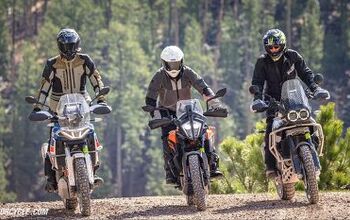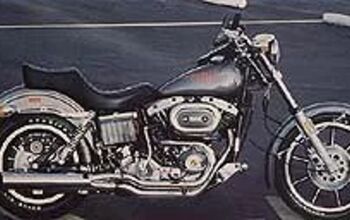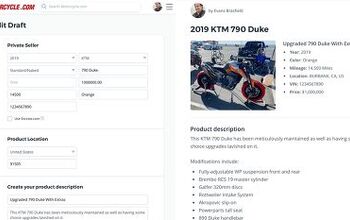Motorcycle.com

Get the Flash Player to see this player.
Many longtime motorcycle enthusiasts lament the good ol days when the versatile design of the UJM (Universal Japanese Motorcycle) allowed its owner to have a do-it-all contraption that handled everything from commuting to touring.These were honest machines unfettered by fairings and blessed with amenable upright ergonomics and comfy seats, allowing them to be nearly whatever its rider wanted it to be.
But in the modern era of motorcycles, the age of specialization has fractured broad segments into tightly compartmentalized sub-genres. The sport-touring category, not long
So for this test, we went back to basics. But instead of revisiting the UJM segment, we looked past Japan to see what was available in the arena of relatively simple bikes that offer a rider a stripped-down mechanical horse that can handle nearly anything thrown at it. The common thread of this comparo is a liter-plus-sized twin-cylinder engine that is left exposed for all the world to admire its air-cooled mechanicalness. To round out the capabilities of the bikes, the option of hard saddlebags was another requirement for inclusion in this test.
We thought we had our group complete until we realized that America offers its own version of air-cooled versatility. The XB12X Ulysses received several updates for 08, so we gathered up an early-release model to see how the improvements have affected one of Motorcycle.coms favorite oddball machines.
Ever the diligent, over-privileged and under appreciated crew of writers, bike wranglers, photo/video wizards and tireless bike testers, we here at Motorcycle.com put this quartet through a myriad of riding assignments, including commuting, backroad exploring, freeway droning and overnight sport-touring.
We've crafted five videos for this shootout, so make sure you click the video link at the bottom of each page.
Let's take a look at what each bike is all about.
2007 BMW R1200R
Vitals at a glance:- $13,075 (includes $475 destination charge); as tested $15,225 (Too many available options to list succinctly)
- 1170cc air/oil cooled fuel-injected eight-valve Boxer Twin; claimed 109 bhp @ 7500 rpm, 85 ft-lbs @ 6000 rpm; measured on Area P Dynojet dyno 95.3 hp @ 6950 rpm,75.9 ft-lbs @ 6450 rpm
- Geometry: 58.9 inch wheelbase; rake angle 27.1 degrees; trail 4.7 inches
- Seat height: 31.5 inches (low seat of 30.3 or high seat of 32.7 inches available at no cost)
- Fuel Capacity: 5.6 U.S. gallons; 1.0-gallon reserve
- Observed fuel economy: 41 mpg
- Dry weight (claimed): 437 lbs.
- Tires: Michelin Pilot Road (120/70 x 17, 180/55 x 17)
Introduced in late 2006 as an early '07 model, the R1200R is one of two nakeds offered by BMW, the other being the speed demon K1200R. The oversquare (101mm x 73mm) 1170cc flat-Twin with a 12.0:1 compression ratio owns the distinction of producing the most power of this group. Its 95 rear-wheel ponies stampede over its class rivals, and its 76 ft-lbs of torque easily out-twists even the burly Buell.
As such, the spread of torque is nice and wide, as are the gear ratios. Although it's a six-speed, that last cog was almost exclusively owned by the freeway. My routine for most of the canyon and otherwise serpentine routes was to simply leave the mostly smooth but notchy-on-the-upshift tranny in fourth gear. This was due in part to the great chassis and excellent brakes, but was an equal testament of the flexibility of the engine. If we over-anticipated a corner, braking earlier than need be, the torquey Twin simply pulled through it effortlessly, salvaging poor riding technique. More importantly, it kept me ahead of Duke Danger as often as possible.
Regular friend-of-Motorcycle.com, Alex Edge, echoed my sentiments about the Beemer's low- and mid-range pull saying, "Just twist the throttle and it goes, whether youre at 3,000 or 5,000 rpm." But without sounding like an ingrate, Alex also noted that time on the interstates revealed an "annoying low-frequency vibration, making itself known at 70 mph and increasing steadily as you move towards 90 mph." Though the buzz didn't create numbness in his extremities, he still felt it was rather irritating the way "it blurred the mirrors to such an extent as to make them nearly useless."
But the big-cube Boxer motor, despite not feeling as sporty as the Ducati powerplant, is the strong-armed thug in this foursome. It produces more power than the rest at nearly every rpm, giving it the grunt to out-hustle everything but the plucky Multistrada.
Because a good share of the engine mass is both low and wide, certain aspects of the handling are affected in a good way, mostly. How does handling benefit? The long-ish wheelbase doesn't lend to sportbike-fast steering response, but the bike can be cranked quickly into a corner thanks to its wide handlebar that is placed fairly high for maximum leverage. Once the R12 is set into a turn, stability is the name of the game.
Although young Alex made a strange analogy between the BMW and the door on a bulletproof limo, he couldn't deny its strong handling traits, commenting that "even aggressive throttle application just past the apex didnt seem to upset the chassis very much."
If youre a harder-core sport rider, adds Duke Danger, the R1200R is the only machine of this quartet that can keep the Ducs taillight in view. And, in the right hands, the Beemer can show its taillight to a Multistrada rider.
The cast-aluminum/tubular-steel/engine-as-a-stressed-member chassis combines well with the linear power of the motor, making the R1200R a very tractable bike to bend through fast sweepers. However, tighter sections of tarmac that require quick direction changes aren't quite as rewarding as, say, on a bike with a higher center of gravity.
While we appreciated the unique Telelever front suspension for its ability to soak up midcorner bumps and its anti-dive properties, it doesnt transmit the amount of feedback from the front tire like a conventional telescopic fork does. And its Paralever shaft-drive rear end, which is virtually maintenance-free and does away with messy chains, cant absorb sharp-edged hits as fluidly as the lighter drive arrangements of the Ducati (chain) or Buell (belt). And although the R12 has a hydraulic rear preload adjuster, its mounted under the seat so it cant be manipulated on the fly like those on the other bikes.
If there's one component aside from its brawny engine that shines on this German-built bike, it's the semi-integral ABS. BMW has recently begun moving away from its hydraulically boosted ABS, slowly implementing the non-linked rear brake, non-servo-assisted 3-pound Bosch system. The beauty of this new brake set-up is that it uses traditional Brembo calipers and stainless steel lines that will function like, well, normal brakes should you find yourself in ABS failure. The days of squeezing the lever and getting mush for the first quarter of its travel before reaching a certain vehicle speed, or hearing that annoying servo whine, are gone.
This newest ABS lacks the abrupt action of the previous system that had a tendency to fall somewhere between not quite there and a 20-ton press, but it doesnt have the most sensitivity at initial application either. Soon thereafter, though, power comes on strong in a rather non-linear manner, ultimately stopping you much sooner than you expected until a rider becomes accustomed to their stellar braking power. I've ridden an R1200R on different occasions over the past year, and the thing that I keep taking away from the experience of braking is that it's much more organic, if you will: the familiar feeling that one gets when using good quality, non-ABS binders. The R12 gets bonus points for having the only (optional) antilock brakes in this group.
Alex "Goldilocks" Edge opined that its ergos were "not too far; not too close," saying that the cockpit was "extremely comfortable," or in fairytale speak, just right. Its 31.5-inch seat is easy to straddle, but its narrow forward section doesnt offer the broad support of its Buell and Guzzi rivals.
Finally, we need to consider some of the goodies that made this bike lean toward touring. Like the simple and roomy saddlebags ($1,014). With a key matched to the fuel cap and ignition, locking, unlocking and releasing the hard bags is a simple affair. When you're ready to call it a day, and want to tote all the stuff you packed, just pull up on the carry handle after turning the lock in the right direction and the bags come off in a snap. It should be noted that whoever was riding behind the Beemer would often observe a rather precarious amount of shaking and vibrating by at least one bag. No worries, though, we never lost one. We suggest carrying your Dom Perignon in a tankbag.
Another appreciated extra is the optional sport windscreen ($210). Small enough to be unobtrusive yet big enough to deflect a goodly amount of wind blast, we were all glad it was on the bike. We also cherished the soothing comfort offered by the Beemers heated grips ($235); as motorcyclists, we suffer enough as it is.
And if there's one piece of steel that shouldn't be optional, it would have to be the $120 accessory centerstand. It should be standard! They make simple maintenance a breeze, not to mention parking in certain situations easier and safer. Yet, they ask so little of you or the bike. At least its available for the Beemer, but its standard equipment on the Guzzi.
For those with money to burn, we suggest ordering the R12 with the supremely convenient ESA suspension system ($800) that allows push-button alterations to damper and spring settings, which wasnt included on our test unit. Then theres also the available tire-pressure-monitoring system and GPS unit, plus higher and lower seats and a taller windshield.
In this collection of four reputable rides, the BMW R1200R can stake at least three claims: the most (available) technology, the broadest spread of power, and the steepest retail figure. Ride stability is fantastic as is the time-tested, refined flat-Twin. But those assets, along with a myriad of others, come with a hefty price tag.
The Perfect Bike For ...the rider who wants a machine that is very tractable and smooth, has more optional equipment than an adult video store, the quality inherent in a Beemer, and has the grip to pay for it all.- Comfy, neutral ergos
- Very accessible and user-friendly spread of power
- Vast array of available options
- Slightly notchy tranny on upshifts; almost demanded use of clutch
- Some engine vibes work through the bars and pegs on freeway
- Costs thousands more than the other three

Motorcycle.com presents an unrivaled combination of bike reviews and news written by industry experts
More by Motorcycle.com Staff




































Comments
Join the conversation